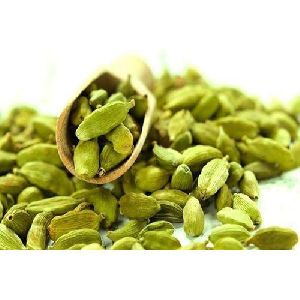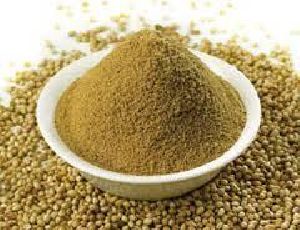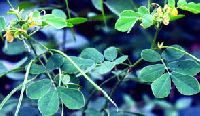
PHENOL RED
3,500 - 4,500 Per Kilograms
25 Kilograms (MOQ)

Turmeric Finger
140 - 250 Per Kgs
Best Deals from Whole Spices

Ajwain Seeds
Get Price Quote
100 Kilogram (MOQ)

Cassia Tora Split
Get Price Quote
Cassia Tora Splits are obtained from the seeds of Cassia Obtusifolia, a plant of the Leguminosae family. The name is derived from Latin words “obtus” meaning blunt and “folium” meaning leaf. This is annual plant that mainly grows after the Indian monsoon season. This plant bears pods of nearly 20cm which contain many cylindrical seeds. These are the cassia tora seeds that are usually broken into two halves and referred to as cassia splits. These splits are usually called by different names like cassia torea splits, senna splits, cassia senna splits etc. Before splitting the seeds are passed through grading machines to differentiate them on the basis of their size. During this procedure, the underdeveloped seeds are removed and C.occidentalis seeds are reduced to no more than 0.05%. The seeds are dehusked and de-germed by thermal mechanical treatment followed by milling and screening of the endosperm.The endosperm is usually separated from the germ. The dehusking of the splits is usually achieved through heating, grinding, polishing and sieving. Cassia splits mainly consists of mannose and galactose units. These are pale yellow splits that are normally soluble in hot water. They act as thickening agents and form gels with carageenan and xanthan. These Cassia Torea splits are often used as food additives. They are used in cattle feed products like dog foods, cat foods, cow foods. The cassia tora split powder obtained from these cassia tora splits are some ancient natural ingredients known for their natural gelling properties. It is used as used as a gelling agent in pet food. It is approved for use in Europe by the Commission Directive (EEC No. E 499) and is listed in the Annex of the Council Directive (70/524/EEC) as a stabilizer, thickening and gelling agent in the manufacture of canned pet foods for cats and dogs. The splits are often used in conjunction with carrageenan and replace the use of Locust Bean Gum or Carob Gum or Guar Gum Splits. They are mostly used in preparing air fresheners in the form of gels. The cassia gum or cassia splits are used as thickeners, emulsifiers, foam stabilizers, moisture retention agents and texturizing agents in cheese, frozen dairy desserts, mixes and poultry products. They are used in all meat containing dishes including salads, appetizers, frozen multi course meat meals and sandwich ingredients prepared by commercial processing or using commercially processed meats with home preparation. Acting as a surfactant, a water soluble agent and an active ingredient the cassia tora is often used in personal care products. The cationic cassia derivatives are suitable for preparation of personal care like cosmetics, toiletries and cosmeceuticals. These are often used in preparation of health care products such as topical and non-topical pharmaceuticals, creams, pomades, gels, pastes, ointments, tablets, gel capsules, suppositories, anti-fungal foams, eye products without limitation.

Green Cardamom
Get Price Quote
After giving tough competition to our contemporaries in Gujarat(India), we have now come forth to challenge the providers in other markets. We are a one-stop destination and the perfect place for purchasing excellence assured Cardamom.

Cumin Seeds
Get Price Quote
Being one of the leading names in the industry, we are instrumental in offering Cumin Seeds to the clients. We carry out our operations from Gujarat, India. We are well-equipped with the modern machines and equipment required for processing them. Their great taste, aroma and long shelf life are highly appreciated by our clients. We offer these seeds in various quantity packs, to cater to the divergent requirements of the clients.

Cassia Tora Gum Splits
50 - 80 Per Kilogram
20 Metric Ton (MOQ)

Coriander Powder
Get Price Quote
Thanks to our modern transit facility, that ensures safe delivery of the orders at required destinations. Our organization has observed impressive rise as Coriander Powder supplier, courtesy our ability to fulfill to wholesale demands without hassle.

Spices
50 - 500 Per kg
100000 kg (MOQ)

Cassia Tora
Get Price Quote
Cassia Tora seed is very hard seeds. It is also bold and small. Cassia plant grows in India after monsoon which comes in June or July. Cassia tora seeds will be collected by poor people from forest in November – December. The Cassia plant mainly grows in the tropical regions of India and is commercially supplied in bulk from regions of Uttar Pradesh and Madhya Pradesh, Chhattisgarh also some part of Gujarat and Maharashtra.

Mustard Seed
Get Price Quote
Mustard seeds are also known as rapeseeds. Mustard seeds are the smallest seeds of the various mustard plants. The seeds are about 2mm in diameter and come in yellowish with to black. French have used mustard seeds as a spice since 800 AD, and it was amongst spices taken by the Spanish on explorations throughout the 1400s. Mustard is highly used in a variety of Indian pickles consisting of mangoes and aavalu powdered mustard and it is very popular in South India. There are many varieties of mustard which come in a wide range of strengths and flavors. The basic taste and heat of the mustard is largely determined by seed type, preparation and ingredients. Black seed mustard is generally regarded as the hottest type. In India, mustard is known both as oil seed as well as spice. Internationally, however, it is more popular as a spice. The genus Brassica consists of over 150 species of annual or biennial herbs several of which are cultivated as oil seed crops like mustard. Other oil seed crops in genus are toria and rapeseed. There are many others, which are cultivated mainly as vegetable like cabbage, collies flower, turnip etc. There are many other, which are being grown as fodder. The mustard seeds of only the above four species have condiment value. The oil yielding Brassicas that are predominantly cross pollinated, constitute a group about which considerable confusion exists, regarding their identification and nomenclature. The mustard flour of commerce is a mixture of the flours of two types of mustard seeds; brown or black mustard (nigra) and white mustard (alba). Mustard condimental properties are largely due to the essential principles of these two seeds. The essential principle or volatile oil of the brown mustard is allyl isothiocyanate, while that of white or yellow mustard is acrimyl isothiocyanate. The essential principles are not present as such in the seeds of brown and white mustards but are produced as a result of hydrolysis of their respective glycosides, sinigrin – potassium myronate and sinalbin, by the action of enzyme myrosin, in the presence of moisture under suitable conditions. Mustard seeds are sold either whole or as a ground powder. Nutritional Profile of Mustard Seeds Mustard seeds are a very good source of selenium and omega-3 fatty acids. They are also a good source of phosphorus, magnesium, manganese, dietary fiber, iron, calcium, protein, niacin and zinc. Cultivation of Mustard The black mustard seed grows throughout Europe, except in the north eastern parts, also in South Siberia, Asia Minor and Northern Africa, and is naturalized in North and South America. It is largely cultivated in England, Holland, Italy, Germany and elsewhere for the sake of the seed, used partly as a condiment, and partly for its oil. Mustard seeds generally take 3 to 10 days to germinate if placed under the proper conditions, which include a cold atmosphere and relatively moist soil. Mature mustard plants grow into shrubs. Mustard grows well in temperature regions. Major producers of mustard seeds include Hungary, Great Britain, India, Canada and the United States. Brown and black mustard seeds return higher yields than their yellow counterparts. Botanical names: Brassica nigra Koch Brassica alba Linn. Brassica hirta Linn Brassica juncea (Linn) Czernjajev. Family names: Crucifereae. English names: True mustard or Black mustard. White mustard, India mustard or Brown mustard. Mustard Oil The seeds yield 23 to 33% of the fixed oil. The volatile oil of mustard is obtained in a yield of 0.7 to 1.2% after the hydrolysis of the glucoside sinigrin, by the enzyme myrosin. Mustard oil for the preparation of volatile oil, the fixed oil is first expressed from the seeds, which are subsequently macerated with tepid warm water for several hours, and steam distilled. The oil obtained is an extremely powerful irritant owing to its volatility and penetrating power, and is responsible for the painful nature of alcohol, or in the Black mustard is ground with white mustard for preparing table mustard and also various medicinal preparations, such as bath mustard, mustard bran and mustard flour. The expressed oil has mild rubefacient properties and is used as a liniment. The technical oil obtained during the preparation of mustard also contains the oil from white mustard seeds. In India seeds of black mustard are used in pickles and curries. Brassica juncea or Indian mustard is a self fertile species, and is a very variable annual. Its narrow based leaves are not stem clasping like those of toria and sarson. Rai matures later than either. The mustard seeds are rugose, reddish brown and generally smaller.

tamarind kernel
Get Price Quote
The company furnishes superior quality tamarind kernel powder in the market. Following are some of the applications of tamarind kernel powder: It is widely used as textile printing thickener. It has excellent penetration & fiber forming property. It is effectively used for sizing in dyeing & printing Industry. It is used as a sizing material in paper industry. It increases the tensile strength of paper and ensures regular distribution of pulp fiber. It is also used for sizing in jute yarn & cotton wraps. It is used as a binder in slurry explosive as a substitute for guar gum. It is very effectively used these days by oil drilling companies as Soil Stabilizer. It is used as a core binder in foundries.

Cassia Tora Split
Get Price Quote
Cassia Tora Splits are obtained from the seeds of Cassia Obtusifolia, a plant of the Leguminosae family. The name is derived from Latin words “obtus” meaning blunt and “folium” meaning leaf. This is annual plant that mainly grows after the Indian monsoon season. This plant bears pods of nearly 20cm which contain many cylindrical seeds. These are the cassia tora seeds that are usually broken into two halves and referred to as cassia splits. These splits are usually called by different names like cassia torea splits, senna splits, cassia senna splits etc. Before splitting the seeds are passed through grading machines to differentiate them on the basis of their size. During this procedure, the underdeveloped seeds are removed and C.occidentalis seeds are reduced to no more than 0.05%. The seeds are dehusked and de-germed by thermal mechanical treatment followed by milling and screening of the endosperm.The endosperm is usually separated from the germ. The dehusking of the splits is usually achieved through heating, grinding, polishing and sieving. Cassia splits mainly consists of mannose and galactose units. These are pale yellow splits that are normally soluble in hot water. They act as thickening agents and form gels with carageenan and xanthan. These Cassia Torea splits are often used as food additives. They are used in cattle feed products like dog foods, cat foods, cow foods. The cassia tora split powder obtained from these cassia tora splits are some ancient natural ingredients known for their natural gelling properties. It is used as used as a gelling agent in pet food. It is approved for use in Europe by the Commission Directive (EEC No. E 499) and is listed in the Annex of the Council Directive (70/524/EEC) as a stabilizer, thickening and gelling agent in the manufacture of canned pet foods for cats and dogs. The splits are often used in conjunction with carrageenan and replace the use of Locust Bean Gum or Carob Gum or Guar Gum Splits. They are mostly used in preparing air fresheners in the form of gels. The cassia gum or cassia splits are used as thickeners, emulsifiers, foam stabilizers, moisture retention agents and texturizing agents in cheese, frozen dairy desserts, mixes and poultry products. They are used in all meat containing dishes including salads, appetizers, frozen multi course meat meals and sandwich ingredients prepared by commercial processing or using commercially processed meats with home preparation. Acting as a surfactant, a water soluble agent and an active ingredient the cassia tora is often used in personal care products. The cationic cassia derivatives are suitable for preparation of personal care like cosmetics, toiletries and cosmeceuticals. These are often used in preparation of health care products such as topical and non-topical pharmaceuticals, creams, pomades, gels, pastes, ointments, tablets, gel capsules, suppositories, anti-fungal foams, eye products without limitation.

DHANA KURIA
Get Price Quote
NEW CROP CORIANDER SEEDS 100% SPLIT FOR MAKING POWDER SPECIFICATIONS : Botanical name – Coriandrum sativum Common name – Coriander, dhana USED IN : Cooking Medicines HEALTH BENEFITS : Contains antioxidants Helps in digestion

Ajwain Seed
Get Price Quote

Black Seed Oil
Get Price Quote
The Kalonji oil or black seed oil is a magical bullet which can best treat health ailments like hypertension, diabetes, cataract, asthma, severe cough, polio, paralysis, arthritis, rheumatic pain, headache, earache, tooth pain, epilepsy, jaundice, cancer, psoriasis and other health problems like uterus problems, skin diseases, diseases related to women and brain problems.

Curcumin
Get Price Quote

Turmeric Powder
135 Per Pack
100 Kilogram (MOQ)

Tamarind Kernel Powder
Get Price Quote
250 Kilogram (MOQ)

Blackpepper
Get Price Quote
Black pepper, scientifically known as Piper nigrum, is one of the most widely used and popular spices in the world. It is native to South India but is now cultivated in various tropical regions worldwide. Here is a description of black pepper: Appearance: Black pepper is a small, round, and wrinkled berry known as a drupe. It starts as green berries on the vine and turns black or dark brown when dried. The outer layer of the dried berry gives it its characteristic wrinkled appearance. Flavor and Aroma: Black pepper has a pungent, spicy, and slightly woody flavor with a subtle heat. Its aroma is aromatic, warm, and enticing. The flavor and aroma come from the compound called piperine found in black pepper. Culinary Uses: Black pepper is an essential and versatile spice used in cuisines worldwide. It is used as a seasoning to enhance the taste of various dishes, both savory and sweet. It can be added during cooking or used as a finishing spice. Grinding: Black pepper is usually sold as whole peppercorns, which can be ground into a fine powder using a pepper mill or mortar and pestle. Freshly ground black pepper has a more potent and aromatic flavor than pre-ground pepper. Health Benefits: Black pepper has been used in traditional medicine for its potential health benefits. Piperine, the active compound in black pepper, is believed to have antioxidant, anti-inflammatory, and digestive properties. It may also enhance the absorption of certain nutrients in the body. Peppercorn Varieties: Besides black pepper, there are other varieties of peppercorns with distinct flavors and colors. White pepper is made from ripe berries with the outer layer removed, resulting in a milder taste. Green pepper is made from unripe berries and has a fresher and more herbaceous flavor. Combination with Salt: Black pepper is often combined with salt to create the classic seasoning known as "salt and pepper." This combination is a staple in many kitchens and is used to season a wide range of dishes. Preservation: Whole black peppercorns have a longer shelf life than ground pepper. To preserve its flavor, it is best to store black pepper in an airtight container in a cool, dry place away from direct sunlight. Overall, black pepper is a beloved and widely used spice that adds depth and warmth to countless culinary creations, making it a staple in kitchens and cuisines across the globe

Cinnamon Powder
600 - 700 Per Kilogram

Coriander Powder
Get Price Quote

Curry Leaves
Get Price Quote

Black Pepper
Get Price Quote

Garam Masala
Get Price Quote

Carboxymethyl Tamarind Kernel Powder
50 Per Kilogram
We are a notable supplier of carboxymethyl tamarind Kernel Powder that is widely used in paper, explosive, drilling, printing industries, etc. The product is extensively used for sizing and printing industry and has first-class penetration and film property. Carboxymethyl Tamarind Kernel Powder is an anionic water-soluble polymer and is derived from Tamarind Kernel Powder. The powder is bio-compatible, bio-degradable, non- toxic and modified natural polymer. The offered product is hygienically processed in compliance with the set industry standard. The offered powder provided by Saku Gums Industries are formulated by advanced methodology using approved components and are highly appreciated for their high effectiveness and long shelf life. The powder is available in customized pack protecting them from light and moisture. Additionally, you can get the offered Carboxymethyl Tamarind Kernel Powder from us at a market leading price.

Fresh Red Chilli
Get Price Quote
Our company is capable of delivering consignments on time owing to an efficient trading network we have. We are instrumental in offering extensive range of products that is in compliance with the internationally accepted standards. Thus, the final products are of excetional quality. Features : Fresh & healthy Loaded with nutrition Strong flavor

Turmeric
Get Price Quote
100000 kg (MOQ)
Turmeric is a common spice and a major ingredient in curry powder. It is promoted as a dietary supplement for a variety of conditions, including arthritis, digestive disorders, respiratory infections, allergies, liver disease, depression, and many others.

Spices
50 - 500 Per kg
100000 kg (MOQ)
Pepper, turmeric, cardamom, and cumin are some examples of Indian spices. Spices are used in different forms: whole, chopped, ground, roasted, sautéed, fried, and as a topping. They blend food

Dry Bhakhri (Coriander Chilli)
Get Price Quote
This product is very very tasty & good for health.